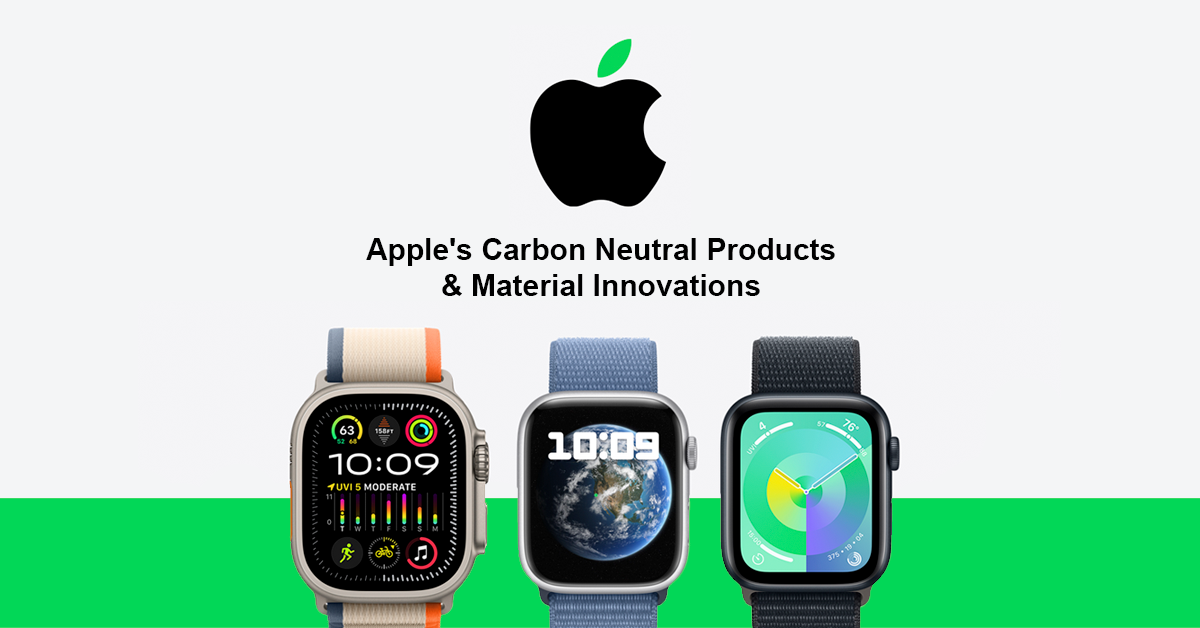
Understanding Apple Inc's Carbon Neutral Ambitions
In recent years, Apple Inc has made significant strides in its commitment to environmental sustainability, particularly in achieving Carbon Neutral status. But what does this mean for the tech giant? Essentially, carbon neutrality refers to the balance between emitting carbon and absorbing it from the atmosphere. For Apple Inc, this entails a comprehensive approach to reducing, offsetting, and eliminating carbon emissions across its operations and supply chain.
The company’s 2030 Zero Carbon Goal is a pivotal aspect of its environmental strategy. This ambitious target underscores Apple’s dedication to achieving complete carbon neutrality within its operations and product life cycles by 2030. This involves not only minimising direct emissions but also addressing indirect emissions associated with manufacturing, transportation, and product usage.
To achieve this goal, Apple Inc is taking proactive steps towards reducing emissions from its products and supply chain. Through innovative design strategies and the integration of recycled materials, Apple has managed to decrease its carbon footprint by a substantial 4.3 million metric tons in 2019 alone. Additionally, the company has achieved an impressive 73% reduction in average energy needed for product use over the past decade.
Furthermore, Apple is heavily investing in renewable energy sources as part of its commitment to carbon neutrality. By relying on 100% renewable energy to power its offices, stores, and data centres since 2018, the company has set a new standard for sustainable corporate operations.
These initiatives are aligned with Apple’s aggressive plan to reduce overall carbon emissions by 75% from 2015 levels. By expanding renewable energy adoption across both corporate operations and the supply chain while incorporating recycled and renewable materials into product designs, Apple has already achieved over a 45% reduction in total emissions since 2015.
One notable example of their efforts is reflected in the latest Apple Watch models which have been designed to be carbon neutral through meticulous attention to detail. By leveraging clean energy throughout the manufacturing process and collaborating with suppliers who utilise clean energy sources, Apple has successfully minimised emissions from materials, electricity, and transportation.

The Role of Material Innovations in Apple's Environmental Strategy
As Apple Inc continues to make strides in achieving carbon neutrality, the role of material innovations becomes increasingly pivotal in their environmental strategy. Sustainable materials play a crucial role in reducing the environmental impact of products, and Apple has been at the forefront of integrating recycled and renewable materials into its product designs.
The Importance of Sustainable Materials
Incorporating recycled and renewable materials into Apple products is a cornerstone of the company’s commitment to sustainability. Through advancements like Daisy, Dave, and Taz, Apple’s disassembly robots, the company has been able to recover more materials at a higher quality than through traditional recycling processes. This innovation allows Apple to contribute material back to the market for reuse, aligning with their goal of using only renewable and recycled materials in their products.
Maximising recycled and renewable content is key to Apple’s 2030 vision as these materials often have a lower carbon footprint than those from primary sources. In fact, the latest Apple Watch models and redesigned bands boast more recycled content than ever before, showcasing Apple’s dedication to sustainable material usage.
Innovations Leading to Carbon Neutral Products
Designing for durability and efficiency is a core principle guiding Apple’s approach towards achieving carbon neutral products. By creating products that are built to last and optimising energy efficiency throughout their lifecycle, Apple minimises waste and reduces the overall environmental impact.
The impact of material innovations on product emissions cannot be understated. For instance, Apple announced its first-ever carbon neutral products in the all-new Apple Watch lineup. Through meticulous attention to detail in design and leveraging clean energy throughout the manufacturing process, dramatic reductions in product emissions of over 75% were achieved for each carbon neutral Apple Watch.
By focusing on sustainable materials and innovative design strategies, Apple Inc is not only setting new benchmarks for environmental responsibility within the tech industry but also inspiring change beyond its own operations.

How Apple Inc's Carbon Neutral Products Set Industry Standards
Apple's Influence on Suppliers and Competitors
Apple’s commitment to achieving carbon neutrality has a profound influence on its suppliers and competitors. By setting ambitious environmental goals and actively working towards them, Apple is encouraging its suppliers to embrace clean energy practices. The tech giant has been leveraging its influence to inspire and support its suppliers in transitioning towards renewable energy sources. This proactive approach not only fosters a more sustainable supply chain for Apple but also sets a precedent for other companies within the industry.
Furthermore, Apple’s dedication to achieving carbon neutrality across its entire value chain by 2030 sets new benchmarks for the tech industry as a whole. The company’s aggressive plan to reduce overall carbon emissions by 75% from 2015 levels while still growing revenue by over 65% demonstrates that environmental responsibility can be integrated into business strategies without compromising financial success. This sends a powerful message to competitors, urging them to reevaluate their environmental impact and adopt more sustainable practices.
The Significance of Carbon Neutral Products in the Market
Consumer Response to Eco-Friendly Products
The introduction of carbon neutral products by Apple Inc has garnered significant attention from consumers who are increasingly conscious of the environmental impact of their purchases. There is a growing demand for eco-friendly products, and Apple’s commitment to sustainability resonates with environmentally conscious consumers. The availability of carbon neutral products not only aligns with consumer values but also reflects positively on the brand, enhancing its reputation as an environmentally responsible company.
The Role of Transparency in Environmental Claims
Transparency plays a crucial role in validating environmental claims made by companies. In this context, Apple Inc’s transparent approach towards achieving carbon neutrality sets an example for the industry. By openly sharing progress reports, data on emissions reductions, and details about sustainable material usage, Apple provides consumers with tangible evidence of its commitment to environmental sustainability. This transparency builds trust and confidence among consumers, empowering them to make informed choices that align with their values.

The Future of Tech: Following Apple Inc's Green Footsteps
Potential Challenges and Opportunities
Balancing Innovation with Environmental Responsibility
As Apple Inc continues to lead the charge in environmental sustainability within the tech industry, it faces the challenge of balancing innovation with environmental responsibility. The company’s commitment to carbon neutrality and sustainable material usage sets a high standard for its competitors, but it also requires continuous innovation to maintain its position at the forefront of technological advancements. This delicate balance between pushing the boundaries of innovation while minimising environmental impact presents both challenges and opportunities for Apple and other tech companies.
The Economic Impacts of Going Green
Transitioning towards environmentally friendly practices can have significant economic implications for tech companies. While initial investments in renewable energy sources and sustainable material innovations may require substantial capital, the long-term benefits include cost savings, improved brand reputation, and compliance with evolving environmental regulations. Moreover, as consumer demand for eco-friendly products continues to rise, embracing green initiatives can open new market opportunities and enhance overall competitiveness in the industry.
The Broader Impact on the Tech Industry
Inspiring Change Beyond Apple Inc
Apple’s unwavering commitment to carbon neutrality and sustainable material sourcing serves as a catalyst for change across the broader tech industry. By openly sharing its roadmap towards achieving carbon neutrality by 2030, Apple provides valuable insights and best practices that can inspire other companies to follow suit. This transparency not only fosters healthy competition but also encourages collaboration towards collective environmental goals.
The Role of Policy and Consumer Demand in Shaping the Future
The future landscape of the tech industry will be significantly influenced by policy developments and consumer demand for sustainable products. As governments worldwide implement stricter environmental regulations, tech companies will need to adapt their operations to comply with these standards. Additionally, consumer preferences for eco-friendly products are driving market forces towards greener alternatives. Therefore, aligning business strategies with evolving policies and consumer demands will be crucial for shaping a more sustainable future for the entire tech industry.
In conclusion, while there are challenges associated with balancing innovation and environmental responsibility, embracing green initiatives presents numerous opportunities for growth and positive impact on both individual companies and the broader tech industry as a whole.
Interviews:
Lisa Jackson: “Apple details its plans to reduce emissions by 75 percent by 2030 while developing innovative carbon removal solutions for the remaining 25 percent of its comprehensive footprint.”




